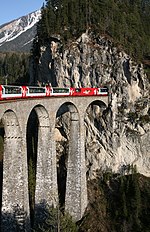Vereina Tunnel
This article needs additional citations for verification. (October 2020) |
Overhead catenary ,11 kV AC 16 2/3 Hz | ||||||||||||||||||||||||||||||||||||||||||||||||||||||||||||||||||||||||||||||||||||||||||||||||||||||||||||||||||||||||||||||||||||||||||||||||||||||||||||||||||||||
| Route map | ||||||||||||||||||||||||||||||||||||||||||||||||||||||||||||||||||||||||||||||||||||||||||||||||||||||||||||||||||||||||||||||||||||||||||||||||||||||||||||||||||||||
|---|---|---|---|---|---|---|---|---|---|---|---|---|---|---|---|---|---|---|---|---|---|---|---|---|---|---|---|---|---|---|---|---|---|---|---|---|---|---|---|---|---|---|---|---|---|---|---|---|---|---|---|---|---|---|---|---|---|---|---|---|---|---|---|---|---|---|---|---|---|---|---|---|---|---|---|---|---|---|---|---|---|---|---|---|---|---|---|---|---|---|---|---|---|---|---|---|---|---|---|---|---|---|---|---|---|---|---|---|---|---|---|---|---|---|---|---|---|---|---|---|---|---|---|---|---|---|---|---|---|---|---|---|---|---|---|---|---|---|---|---|---|---|---|---|---|---|---|---|---|---|---|---|---|---|---|---|---|---|---|---|---|---|---|---|---|---|
| ||||||||||||||||||||||||||||||||||||||||||||||||||||||||||||||||||||||||||||||||||||||||||||||||||||||||||||||||||||||||||||||||||||||||||||||||||||||||||||||||||||||
The Vereina Tunnel is a railway tunnel, and the principal part of the Vereina railway line, in the
First proposed during 1975, construction of the tunnel commenced during 1991 and was officially completed on 19 November 1999, ahead of schedule. In the first year alone, roughly 280,000 vehicles were recorded as having used the tunnel; since then, its usage has risen to around 450,000 vehicles per year. At 19,042 metres (62,474 ft) in length,[1] the Vereina Tunnel is the longest tunnel on the Swiss Rhaetian Railway (RhB) network as well as the world's longest metre-gauge railway tunnel.
History
As early as 1975, the administrative council of the government of the Swiss
Following the approval of the proposal by the
The construction schedule had called for the tunnel to be completed after nine years of work; however, a greater rate of progress than this conservative projection was achieved, thus construction was completed nearly six months ahead of schedule.[2] This was despite the need for unplanned remedial work, such as the reprofiling of 20 meters of the northern bore after fracturing had brought about a temporarily standstill in the work.[5] The total cost of the Vereina Tunnel reportedly came to CHF 670 million.[6]
On 19 November 1999, a ceremony was held, attended by various officials such as the then Federal Councillor and Transport Minister
Service is based on hourly regional trains between
References
Citations
- ^ "Key figures". Chur, Switzerland: RhB. Retrieved 16 August 2019.
- ^ a b c d e f g h Suter, Erika (19 November 2019). "Mountain conqueror – the Vereina Tunnel celebrates 20 years". Rhaetian Railway.[dead link]
- ISSN 0956-8700. Retrieved 18 December 2023.
- ^ Peila, Viggiani and Celestino 2019, p. 3208.
- ^ Ramoni 2020, p. 33.
- ^ "Vereina Tunnel: Safety Concept" (PDF). Amber Engineering. Retrieved 17 April 2020.
- ^ "Spatial Effects of the Vereina Tunnel". europa.eu. January 2004. Retrieved 18 December 2023.
- ^ "Rail tunnel Vereina". Amber Engineering. Retrieved 17 April 2020.
- ^ "Hot Water from the Tunnel for generating Power". June 2014. Retrieved 18 December 2023.
Bibliography
- Peila, Daniele., Giulia Viggiani and Tarcisio Celestino. Tunnels and Underground Cities. Engineering and Innovation Meet Archaeology, Architecture and Art. CRC Press, 2019. ISBN 0-4297-5502-3.
- Ramoni, Marco. On the Feasibility of TBM Drives in Squeezing Ground and the Risk of Shield Jamming. vdf Hochschulverlag AG, 2010. ISBN 3-7281-3363-9.

